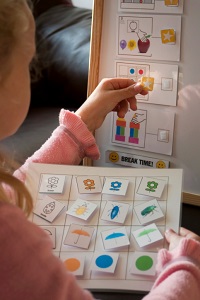 Transitions: What Are They? Why Are They Difficult for Children with Autism?
Transitions: What Are They? Why Are They Difficult for Children with Autism?
A transition occurs when there is some sort of change to the parameters of an activity or situation, such as going from one activity to a different activity or changing plans. For example, going from playing computer to doing homework, riding the school bus home, going on vacation, going out for ice cream with dad when you planned on doing that with mom — all represent examples of transition situations.
The problem with transitions is that either something is ending, or something is beginning. Often, this means going from doing something preferred to doing something nonpreferred. This can be problematic for just about anyone. For the autistic individual who is very driven by being comfortable, being obligated to stop doing preferred, comfortable activities is even tougher. After all, why would one want to stop playing a favorite video game just to take a bath?
As for all human beings, as well as for individuals on the spectrum, transitions mean uncertainty. Increased uncertainty means increased anxiety. New situations mean different rules and expectations. Rigidness and routine adherence are coping characteristics of autism, and these serve to reduce uncertainty, thereby reducing anxiety. These qualities tend to make transition situations that much more difficult.
Here are a few things you, as a parent, can do to make transitions a little easier for yourself and your child.
Scheduling: Planning Ahead to Reduce Anxiety
Since uncertainty and the anxiety that goes with it is a large part of the problem with transitions, it makes sense that reducing uncertainty might make transitions easier. Scheduling is an easy way of doing this.
Providing your child with a schedule does two things: It allows your child to have a better sense of what is going to happen in the future, and provides a better sense of control over his life (if you make him a part of the scheduling process).
Here are some tips to maximize the effectiveness of your scheduling strategy:
- Schedules should be understandable. Make sure the schedule is written in such a way that the child can read/utilize it. Use pictures instead of words if that will make things more concrete for him/her.
- Schedules need to be seen to be effective. Make sure the schedule is easily available or can be carried by your child so they can refer to it whenever they need to do so.
- Scheduling should be a collaborative activity. Whenever possible, give your child both choices of activities and the order in which they will be done. This increases your child’s sense of control and reduces uncertainty and anxiety.
The “Ease-in” Proactive Warning Strategy
Give your child as much warning as possible about upcoming transitions. Instead of just springing change on your child with little or no warning, give him/her time to mentally process and prepare for the change. Making the sudden mental shift from one activity to another can just be too much for some kids.
Give your child progressive reminders of the upcoming change. So, 10 to 15 minutes before the transition is going to occur, tell your child of what is going to happen, when it is going to happen, and what they need to do. Do this again a few more times, maybe at five minutes and two minutes. You can also do this when the activity itself hasn’t changed but other details of the activity have changed (change in time, who’s going, order of activities, etc.) Giving repeated reminders of what is going to occur beforehand helps reduce uncertainty and alleviate anxiety for your child.
Priming: Setting Expectations ahead of Time
This strategy is simply a variation of the “ease-in” strategy. This is where you review what is going to happen and what the expectations are before going into a given situation. The difference between this and the “ease-in” is that this is done just prior to the transition. It puts your expectations forefront in your child’s mind and makes it more likely that they will remember them. It’s not a guarantee they will follow directions, but it stacks the deck in your favor.
I often use this for more familiar activities. For example, every time I take my kids to the store, I say the following:
“OK kids, we are about to go in the store. Let’s review the rules. We are here to buy [x] and [y]. If you are good, I may get you [z]. Please keep your hands and feet to yourselves. Follow my directions. We will use the bathroom as soon as we get in and that’s it. Finally, if you can’t see me, I can’t see you, so let’s stay together.”
I’ve said this or something like this before every shopping trip with my kids for years. They can sometimes recite it with me. My kids have learned to stay with me in the store. They don’t ask to go to the bathroom 15 times during a shopping trip. They generally behave well, and earn treats as a result. It was not always so easy.
“Grandma’s Law:” The Power of the Premack Principle
The premack principle, or “grandma’s law,” refers to alternating between nonpreferred and preferred activities. In essence, it’s “if you want dessert, you need to finish your vegetables.” By doing this, you can always give your child something to which to look forward, even when he/she has to do something they don’t like doing. This strategy both reduces uncertainty and increases compliance through increased motivation (people are more willing to do nonpreferred activities if this gets them access to or leads to preferred activities).
Incidentally, premacking works really well with scheduling. Alternating between preferred and non-preferred activities will increase the power and motivation of the schedule. This, in turn, will make it easier for your child to make the transitions.
One Last Piece of Advice
These strategies work really well together. Furthermore, the more consistently they are used the better they work. To get this to happen, it behooves you, as parents, to train the other caregivers in your child’s life as to how best to guide them through transition situations. When the child’s parents, teachers, babysitters, home health therapists, etc., are all doing the same thing, your child is going to experience less uncertainty and, therefore, less stress. This, in turn, should result in fewer negative behaviors and better transitions.
I hope you found this information useful and that it makes life with your child a little easier. As always, remember to breathe… you got this.

The preceding article was solely written by the author named above. Any views and opinions expressed are not necessarily shared by GoodTherapy.org. Questions or concerns about the preceding article can be directed to the author or posted as a comment below.

 Children with Autism Spectrum: Communication and Behavior
Children with Autism Spectrum: Communication and Behavior Autism Spectrum and the DSM-V: More Questions Than Answers
Autism Spectrum and the DSM-V: More Questions Than Answers How to Help the Special Needs Child Transition Back to School
How to Help the Special Needs Child Transition Back to School

Please fill out all required fields to submit your message.
Invalid Email Address.
Please confirm that you are human.
Leave a Comment
By commenting you acknowledge acceptance of GoodTherapy.org's Terms and Conditions of Use.